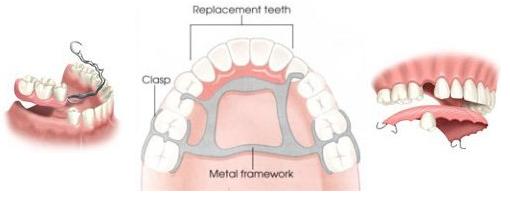Partial Dentures
As an alternative to bridges and implants, dentures can be used to replace several missing teeth. It is possible to get either full or partial dentures. Full dentures remain in place by form fitting to the gum ridges. This creates a strong suction that is usually enough to keep them comfortably in place. Partial dentures often have additional ridges that fit around the natural teeth helping them stay in place.
Implants used for an over denture are fitted with a ball screw. This allows the denture to be firmly snapped into place. It takes several visits to the dentist in order to be properly fitted with a denture. The dentist will take several impressions of the gums, and send these to a dental lab. The lab uses these impressions to construct your dentures. On the next appointments you and your dentist will check the dentures to ensure that your fit is correct and that the dentures meet your approval.
New dentures may feel awkward for a few weeks until you become accustomed to them. The dentures may feel loose while the muscles of your cheek and tongue learn to keep them in place. It is not unusual to experience minor irritation or soreness. You may find that saliva flow temporarily increases. As your mouth becomes accustomed to the dentures, these problems should diminish. One or more follow-up appointments with the dentist are generally needed after a denture is inserted.
Eating will take a little practice. Start with soft foods cut into small pieces. Chew slowly using both sides of your mouth at the same time to prevent the dentures from tipping. As you become accustomed to chewing, add other foods until you return to your normal diet. Continue to chew food using both sides of the mouth at the same time. Be cautious with hot or hard foods and sharp-edged bones or shells.



